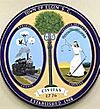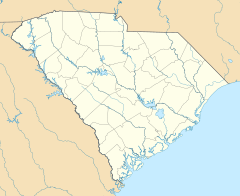Elgin, Kershaw County, South Carolina facts for kids
Quick facts for kids
Elgin, Kershaw County,
South Carolina |
||
|---|---|---|
|
||
| Nickname(s):
Home of the Catfish Stomp
|
||
| Motto(s):
"Small Town with a Big Heart"
|
||
| Country | United States | |
| State | South Carolina | |
| County | Kershaw | |
| Area | ||
| • Total | 1.08 sq mi (2.80 km2) | |
| • Land | 1.08 sq mi (2.80 km2) | |
| • Water | 0.00 sq mi (0.00 km2) | |
| Elevation | 400 ft (100 m) | |
| Population
(2020)
|
||
| • Total | 1,634 | |
| • Density | 1,510.17/sq mi (582.86/km2) | |
| Time zone | UTC-5 (Eastern (EST)) | |
| • Summer (DST) | UTC-4 (EDT) | |
| ZIP code |
29045
|
|
| FIPS code | 45-23245 | |
| GNIS feature ID | 2406432 | |
Elgin is a town in South Carolina, located mostly in Kershaw County. A small part of it is also in Richland County, South Carolina. It's about 20 miles (32 km) northeast of Columbia, the state capital.
In 2010, about 1,311 people lived in Elgin. By 2020, the population had grown to 1,634 people. Elgin is part of the larger Columbia Metropolitan Area.
Contents
Where is Elgin Located?
Elgin is in the southwestern part of Kershaw County. It sits along U.S. Route 1, a main road that goes southwest to Columbia and northeast to Camden, the county seat. The town covers an area of about 1.08 square miles (2.80 square kilometers), and it's all land.
Elgin is in a special area called the Carolina Sandhills. This region has many sand dunes that were formed by wind during the last ice age. Today, plants cover these dunes, keeping them stable.
In late 2021 and 2022, the area around Elgin experienced more than 40 earthquakes. Some of these were strong enough to be felt, with the largest one measuring 3.6 in strength.
What is Elgin's Climate Like?
Elgin has a humid subtropical climate. This means it has hot, humid summers and mild winters.
- The hottest temperature ever recorded in Elgin was 109°F (43°C) on June 30, 2012.
- The coldest temperature ever recorded was -2°F (-19°C) on January 21, 1985.
White Pond: A Local Landmark
White Pond is a well-known natural spot in Elgin. It includes a sand dune formation and a 66-acre natural lake. This lake was formed a very long time ago, possibly during the last Ice Age, by wind-blown sand blocking water flow.
White Pond is special because its sediments have kept a long record of the area's past. Scientists have taken samples from the pond that show what temperatures were like during the Ice Age and what plants and animals lived there. One sand dune at White Pond is about 92,300 years old!
The pond is home to plants typical of sand dunes, like the longleaf pine tree and British Soldier's Lichen. There's also a poisonous flowering vine called Gelsemium sempervirens.
White Pond was even marked on a map of Kershaw County made by architect Robert Mills in 1825. Today, there's a log cabin there that belongs to a private fishing and game club, and the lake is stocked with trout.
Since 2015, archaeologists led by Dr. Christopher Moore have been studying the site every year. They work with the USC Educational Foundation and other groups. In 2017, they found signs of people living there during the Late Paleoindian Dalton period. It's believed that people from the Clovis culture lived in the area at least 12,500 years ago. In 2019, they found tools like an Edgefield scraper and a Kirk Notched point, which are artifacts from the early Archaic period.
Who Lives in Elgin?
The population of Elgin has grown quite a bit over the years:
- 1910: 116 people
- 1950: 183 people
- 2000: 806 people
- 2010: 1,311 people
- 2020: 1,634 people
Elgin's Population in 2020
In 2020, there were 1,634 people living in Elgin. Most of the people (about 72.6%) were White. About 15.5% were Black or African American. Other groups included Asian, Pacific Islander, and people of mixed races. About 5.7% of the population was Hispanic or Latino.
There were 597 households in the town, and 488 of them were families.
Elgin's Population in 2010
In 2010, Elgin had 1,311 people. About 83.5% were white, and 11.1% were black. A small number of people were American Indian, Asian, or of mixed race. About 5% of the population was Hispanic or Latino.
There were 484 households, and 375 of them were families. About 38.2% of households had children under 18. Most households (61.2%) were married couples.
The average age of people in Elgin was 36.8 years. About 29.9% of people were under 20, and 15.7% were over 60.
Most adults in Elgin (89.1%) had graduated from high school or had a higher education. The average income for a household was $58,500.
Elgin's History
Elgin has had a few different names over time. It was first called "Jeffers" and then "Blaney" before becoming "Elgin."
The town's history began in 1898 when a post office was set up in the area. The community was named Jeffers after its first postmaster, William T. Jeffers. The town started to grow more in 1900 when the Seaboard Air Line Railroad expanded through the area.
Later, the town and post office were renamed Blaney. This was to honor a New York banker who helped pay for the railroad expansion. The town of Blaney officially became a town on January 23, 1907.
Jesse T. Ross was Blaney's first postmaster and served for 47 years. He and D. D. Evans opened the first business in town. A brick schoolhouse was built in 1912. For a while, the town didn't grow much. But by 1930, Blaney had its own high school.
In 1931, U.S. Highway 1 was completed. This paved road ran parallel to the railroad and brought new visitors and businesses to Blaney. It's still the main road into town today.
In the late 1950s, more industries came to the area. In 1958, the Whitehead Brothers Sand Company opened a large sand foundry nearby. Then, in 1962, the Elgin National Watch Company decided to move to the area. They liked the empty land and the chance to hire workers from nearby Columbia.
Because of the new watch company, residents voted to change the town's name from Blaney to Elgin. The vote was a landslide, with 61 votes for Elgin and 16 for Blaney. In September 1962, plans were confirmed to build a $1 million assembly plant in the town. This plant created 240 jobs and received over a thousand applications.
With the new plant, Elgin improved its water system. By 1963, the plant was making products. However, in 1967, the Elgin National Watch Company sold the plant to B. F. Goodrich, a company that made tennis shoes. This happened because the watch company couldn't compete with watches made in other countries. That same year, Hardwicke Chemical Company started building a facility near Elgin.
Elgin has continued to grow in recent years. In 2005, a new sewer system was finished, and a new building for the town hall, police, and fire station was completed. The town's population grew by over 50% between 2000 and 2010, and it continues to grow. As of July 2024, Elgin's mayor is Melissa Emmons.
Getting Around Elgin
Since 1931, US Route 1 has been Elgin's main street. It runs next to Interstate 20. You can get to Elgin from Interstate 20 by taking Exit 87, which is about 3 miles (5 km) southeast of the town center.
Main Roads in Elgin
- Interstate 20
- US Route 1
- SC Highway 12
Schools in Elgin
Elgin has several schools for students:
- Lugoff-Elgin High School
- Lugoff-Elgin Middle School
- Leslie M. Stover Middle School
- Blaney Elementary School
- Doby's Mill Elementary School
The town also has a public library, which is a branch of the Kershaw County Library.
Fun Things to Do in Elgin
Elgin is known for its annual event called the Catfish Stomp. This is a Christmas parade that happens every year on Main Street.
Images for kids
See also
 In Spanish: Elgin (condado de Kershaw) para niños
In Spanish: Elgin (condado de Kershaw) para niños






